March 3, 2014
by Carole Zangari -

We get so many questions about the best way to ‘do’ literacy with AAC learners that decided to build on the earlier posts from and talk more about the ways in which we can support the development of reading and writing skills. For AAC learners, the most important skill set (after communication) is the ability to read and write. When given the chance, we’d teach literacy before almost anything else. Why? First, because it opens the door to so many things. When someone can read and write they are more likely to be successful with academics, find jobs and develop real careers, and enjoy productive leisure time. Secondly, we find that it changes people’s perceptions of an AAC learner. When they see Billy writing or reading with comprehension, they understand that his severely limited speech does not reflect his intellect, motivation, or potential. It shapes their perception of him to... [Read More...]
Filed under: Strategy of the Month
Tagged With: Center for Literacy and Disability Studies, Jane Farrall, literacy, reading, writing
February 24, 2014
by Robin Parker -
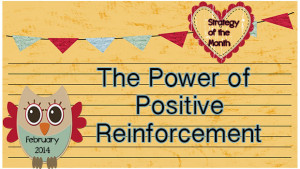
Positive Reinforcement has a lot of power but it is a lot more than making a learner feel good about themselves. Positive reinforcement is the response to a behavior that will make that behavior occur again. In AAC and teaching terms, we are often thinking about a communicative or language behavior. We can also be thinking about a participation behavior that will allow a learner to have more access to meaningful language experiences. We are not usually thinking about ‘good art’ or ‘great work’. By keeping in mind some top positive reinforcement strategies, you will be prepared to have varied individualized strategies that will make it most likely that the communication behaviors you are teaching will spontaneously occur again and again. Power Positive Reinforcement Strategies for AAC Learners: Natural Positive Reinforcers– It is naturally reinforcing to ask for an item and then be given that item. It is naturally reinforcing... [Read More...]
Filed under: Strategy of the Month
Tagged With: Learning, positive reinforcement
February 17, 2014
by Carole Zangari -
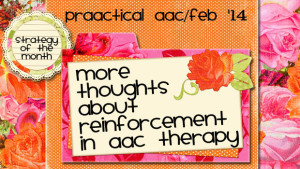
When we’re teaching AAC, our preferred means of responding to learners is with natural consequences, expansions, extensions, and verbal encouragement. Here are some of our prAACtical thoughts. Natural Consequences Nothing says ‘power’ like having someone respond based on what you just said. SLPs are quite familiar with this concept and use this regularly to provide ‘more’ tickles, crackers, and music. When we work with beginning communicators, we’re all about providing quick access to whatever the AAC learner requests. But we tend to lose sight of the need for natural consequences when working with learners on higher level language skills. True, it is more difficult to think of the natural consequence when we’re working on morphology, syntax, and semantics, but the principle is the same: Learning is enhanced when our responses are driven by the message that our client just produced. We’re working with Antonio to reduce ambiguity in his messages.... [Read More...]
Filed under: Strategy of the Month
Tagged With: encouragement, expansions, extensions, natural consequence, reinforcement, token board
February 10, 2014
by Carole Zangari -
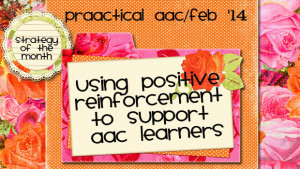
In terms of reinforcement, Jamie kept me on my toes. Initially, she preferred to be by herself so that she could do her own thing without any demands placed on her. Solitary time is not our favorite way to reinforce desired behavior, but it was a start. Jamie earned little bits of free time where she could have some uninterrupted play. Then, she seemed to like anything that she could line up. No sweat. (This is progress! We were much happier to see her desire things as opposed to the absence of company. We had lots of things that we could use and she loved the novelty of materials we presented…for short awhile). Quickly, that morphed into things that she could line up that had letters. Got it! (We can repurpose some alphabet puzzles/games and we’re good!). Then, things got interesting. One week there was an intense love of... [Read More...]
Filed under: Strategy of the Month
Tagged With: feedback, positive reinforcement
February 3, 2014
by Carole Zangari -
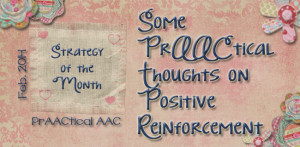
SLPs know that positive reinforcement is a key therapy tool with an evidence base for many types of AAC learners. This month, we’ll focus on making positive reinforcement work in our AAC therapy sessions. Reinforcement is a topic that has gotten a ton of attention in other blogs and websites, particularly those focused on autism, so there is no need to reinvent that wheel. Instead, you can do a web search and/or look at these posts/pages and we’ll focus more specifically on its application to AAC. Here are some places to check out if you want more information on basic concepts in reinforcement. Most approach it from a behavioral perspective. Video lessons on reinforcement from the MIND Institute at the University of California (Davis) here and here. Overview of Reinforcement as EBP Implementing Positive Reinforcement In the meantime, here are some thoughts on positive reinforcement within the context of AAC therapies... [Read More...]
Filed under: Strategy of the Month
Tagged With: encouragement, positive reinforcement, praise
January 27, 2014
by Robin Parker -
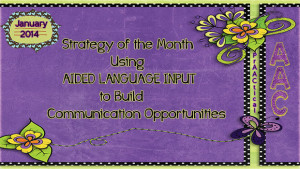
We can not write, speak or do enough Aided Language Input (ALI). If we expect learners to speak AAC, we must speak AAC to them. It is difficult enough to learn a language and imagine if no one spoke it to you in the language you were expected to speak…But there are so many more reasons to do ALI. Aided Language Input (ALI) belongs in the context of communication opportunities. It is modeling AAC style. Once we model a target language concept AAC style, then add the wait and signal strategy, the learner then knows it is their communicative turn. Especially if you wait with the raised eye brow signal. They often will take their turn expressively. But, if they do not take the communicative opportunity to take their turn, there are gestural, visual, verbal, and physical prompts that can be implemented. In other words, they can make use of... [Read More...]
Filed under: Strategy of the Month
Tagged With: aided language input, ALI, communication opportunities
January 20, 2014
by Carole Zangari -
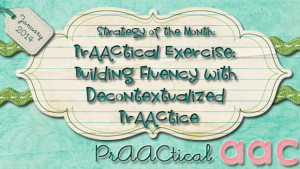
In most situations, communication teaching must be steeped in a meaningful context. SLPs build their plans for teaching new concepts or communicative intents around things that are relevant and important to the AAC learner. How do you teach ‘more’ without something the learner wants more of? How do you teach ‘fast’ without making something zip around? It just wouldn’t work. We get the role of context and have written many posts emphasizing the central part it must play in AAC intervention. Is there are prAACtical place for therapy activities that are NOT embedded in a rich semantic context? We think so. First, a word about what we mean when we talk about therapy activities that are decontextualized. We’re talking about activities in which there is not necessarily a connection between the semantics and the outcome for the AAC learner. (For example, saying a sentence with ‘more’ in it, does NOT... [Read More...]
Filed under: Strategy of the Month
Tagged With: All Turn It, context, fluency, Opportunities, Picture WordPower, practice, Speech Room News, Toca Boca
January 13, 2014
by Robin Parker -
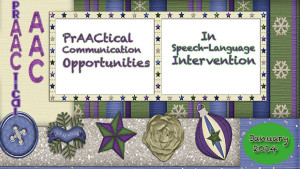
Planning for communication opportunities in every aspect of speech-language therapy helps ensure productive use of time and effort for both clinician and learner. It is not enough to talk to a student, it is not enough to provide fun activities without lots of opportunity for active participation and more specifically communication initiation. Another word for communication initiation/opportunities is communication temptations. Communication temptations are structured situations designed to entice a variety of specific communication functions or semantic relations (Wetherby, 1988). There needs to be lots of times where there is targeted modeling and then a specific, obvious reason for the learner to be the initiator of communication. A temptation to communicate. Take a look at this sample therapy session for frequent and multiple communication opportunities. Please let us know a favorite or creative communication opportunity that you use. PrAACtical Considerations Meaningful AAC Goals– All quality speech-language intervention sessions start with meaningful... [Read More...]
Filed under: Strategy of the Month
Tagged With: communication opportunities
January 6, 2014
by Carole Zangari -
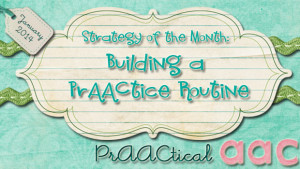
There’s an old joke about a tourist wandering around New York City in search of the famed musical venue that has been home to countless performances of classical music. After walking in circles, he finally stops a resident to ask for directions, “How do you get to Carnegie Hall?” “Practice, practice, practice,” was the reply. And so it is with AAC. No matter what their age or disabling condition, there is one thing that every AAC learner needs: Practice. A lot of it. It takes a lot of daily practice for people learning to use AAC in order for them to: Become fluent with their AAC systems Build their vocabularies Develop their syntactic skills Respond more quickly Communicate less effortfully As we’ve said before, we tend to like things that we’re good at and things that are relatively easy for us. It time and a lot practice for some of... [Read More...]
Filed under: Strategy of the Month
Tagged With: Activity Objective Matrix, documentation, download, form, planning
December 28, 2013
by Carole Zangari -
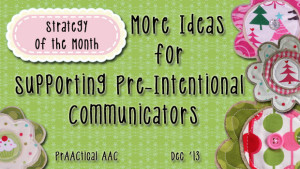
This month, we’ve been talking about how to support individuals who are at the earliest levels of communication: the perlocutionary or pre-intentional stage. Although everyone goes through a stage at which behavior is considered communicative only because the partner perceives it that way, some individuals linger there for months or years. What steps can SLPs take in order to help these children and adults have meaningful interactions and build more effective communication skills? Here are some prAACtical thoughts on the matter. Prepare for Skepticism Some people in the client’s life may not believe that there is real potential for communication growth. This is particularly true for learners who are a bit older. When children reach the late elementary school and are still at the pre-intentional stage, there is a tendency to fear that ‘real’ communication is beyond the learner’s grasp. In our view, that is rarely the case. VERY rarely.... [Read More...]
Filed under: Strategy of the Month
Tagged With: beginning communicator, cause-effect, consistency, preintentional communication, touch cue









